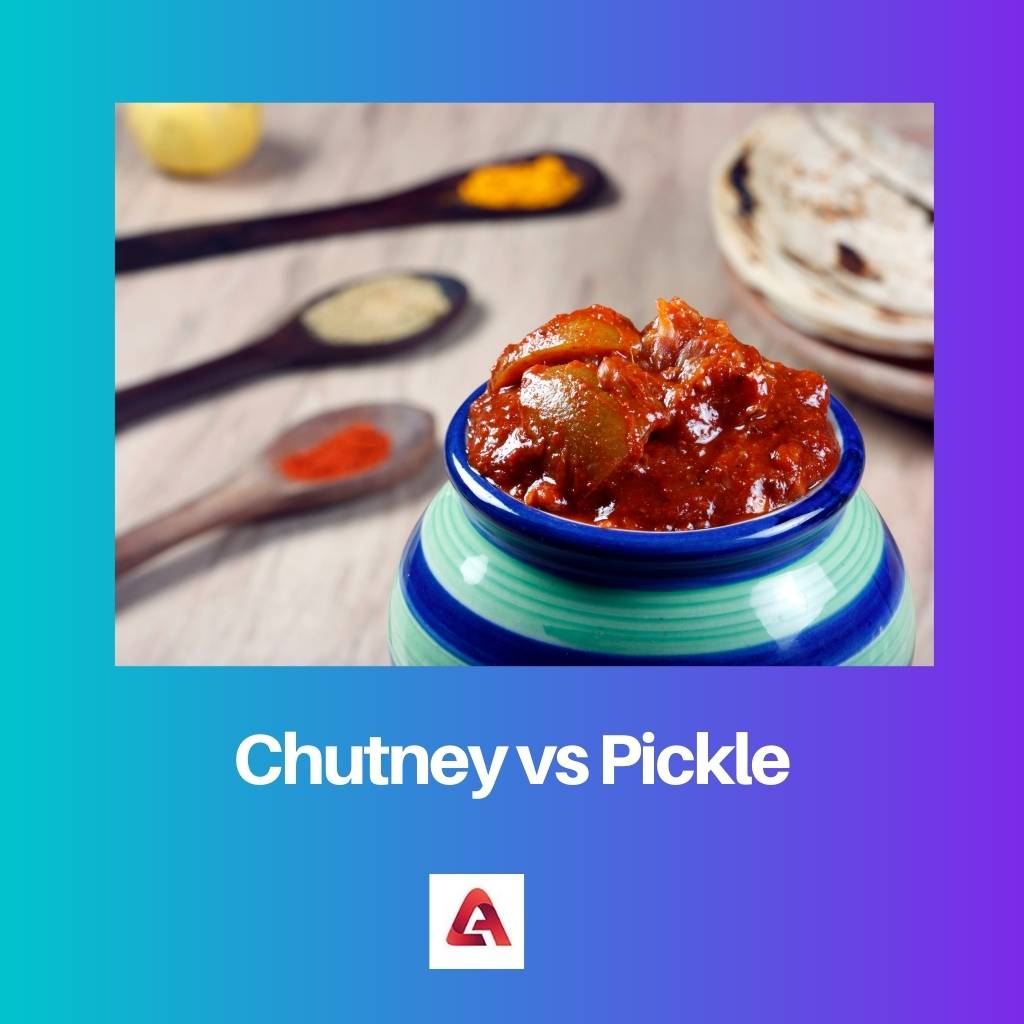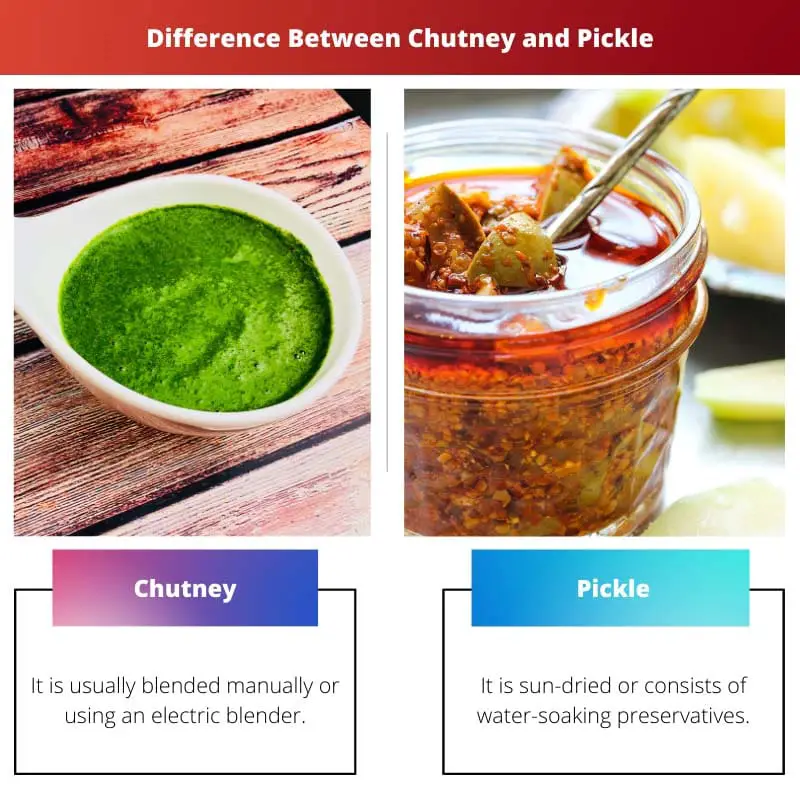Chutney and pickle both are savory, spicy, and sour or sweet in taste. They are eaten with dishes that are bland.
Key Takeaways
- Chutney is a condiment made from fruits, vegetables, spices, and vinegar, with a sweet, tangy, or spicy flavor, commonly used in Indian cuisine.
- Pickle involves preserving fruits or vegetables in a vinegar or brine solution, resulting in a sour, tangy taste, and can be eaten as a side dish or snack.
- Chutneys are smoother and have shorter shelf lives, while pickles have a longer preservation time due to the pickling process.
Chutney vs Pickle
Chutney is a gluten-free, spicy, or savory condiment or spread associated with cuisines of the Indian subcontinent. It is made using small, chopped pieces of fruits or vegetables and has a smooth consistency. A pickle is a relish made using whole fruits and vegetables preserved in vinegar or brine.

Chutney is a smooth paste that is spicy or sweet in taste. It is served as a condiment with several dishes. Chutney helps to enhance the taste of any food. It can also be used as a side dip for chips.
Pickle involves large chunks of vegetables and fruits, which are covered with various types of spices. A pickle can be stored for a longer period of time.
Comparison Table
| Parameters of Comparison | Chutney | Pickle |
|---|---|---|
| Preservative | It does not contains preservatives. | It does contain either natural or artificial preservatives. |
| Consistency | It has a smooth consistency. | It contains chunks of fruits or vegetables. |
| Preparation | It is blended manually or using an electric blender. | It is sun-dried or consists of water-soaking preservatives. |
| Origin | It is originally from India. | Every country has its own types of pickles. |
| Lasts for | It lasts for less time compared to a pickle. | It lasts longer than chutney. It can even last for years. |
What is Chutney?
Chutney is an origin from India. Chutney is a Hindi word that basically means to lick. Chutney is served as a side dish so as to enhance the food taste.
Chutney does not contain many calories. It is made freshly at homes or shops. Most chutney does not have any kind of preservatives in them.
Chutney in ancient India was made by grinding spices and vegetables or fruits in a big vessel. It used to be ground using a stick with the efforts from hand for a few minutes.
Chutney is served with food like samosas, bread or naan, dosha, salads, chicken, momos, etc. It is also used as a spread for sandwiches, rolls, wraps, etc.

What is Pickle?
A pickle is a very famous condiment; it is available in sweet, spicy, and sour flavors. Pickle is made using vegetables and fruits.
Pickle is known for its tangy and spicy flavor, which can make any food very yummy. Pickle is preserved using natural preserving substances like oil, vinegar, salt solution, lemon juice, etc.
Pickles are a part of very ancient times in which food was preserved naturally so as to reduce the waste of food. A small piece of pickle is enough to trigger the taste buds.
There are various types of pickles like mango pickles, lime pickles, carrot pickles, cucumber pickles, kimchi (traditional Korean pickles), Hungarian pickles, Kool-Aid pickles, etc.

Main Differences Between Chutney and Pickle
- Chutney does not contain any kind of preservatives, whereas pickles can contain both natural and artificial preservatives.
- Chutney is originally from India, whereas many countries have their own styles of pickle.

- https://www.ars.usda.gov/ARSUserFiles/60701000/Pickle%20Pubs/p37.pdf
- https://www.researchgate.net/profile/Prabhakara-Pamidighantam/publication/326300317_Chemical_composition_standardisation_and_storage_studies_on_raw_mango_chutney_powder/links/5b44aae2aca272dc385c9627/Chemical-composition-standardisation-and-storage-studies-on-raw-mango-chutney-powder.pdf

The content is well-researched and offers a comprehensive comparison between chutney and pickle. It covers various aspects such as consistency, preservation, and cultural origins. Quite insightful.
The detailed explanation of chutney’s and pickle’s characteristics alongside their historical backgrounds makes this article a valuable resource for enthusiasts of ethnically diverse cuisine.
I appreciate the informative nature of the article, addressing the parameters of comparison and the key takeaways. It has been a genuinely enriching read.
The insightful portrayal of chutney and pickle, including their historical roots and nutritional aspects, demonstrates an exceptional level of scholarly research and writing. It’s a thoroughly enriching article for those fascinated by the diversity of global cuisines.
The comprehensive analysis of chutney and pickle, accompanied by historical and cultural insights, elevates the understanding of these condiments. This article is a testament to the cultural significance embedded in culinary traditions.
I appreciate the thoroughness with which this article explores the nature of chutney and pickle, shedding light on their differences in various parameters. It’s a commendable read for those intrigued by multicultural cuisines and food preservation methods.
The attention to historical, cultural, and culinary details in this article is truly impressive. It provides an intriguing narrative that delves into the significance of chutney and pickle in the global culinary landscape.
I found this article to be a compelling analysis of chutney and pickle, offering comprehensive details on their characteristics, origins, and preservation techniques. It’s truly an enlightening piece for culinary enthusiasts and researchers.
The references and sources integrated into this article add substantial credibility and accuracy to the information presented. It’s remarkable to have such detailed insights into chutney and pickle in one platform.
The meticulous comparison between chutney and pickle, coupled with their cultural origins and distinct characteristics, offers a compelling narrative on condiments. It’s a scholarly piece that provides valuable insights into the world of global gastronomy.
This article is a testament to the breadth and depth of knowledge encapsulated within culinary traditions. It presents an insightful comparison of chutney and pickle, portraying their cultural significance and diverse culinary roles.
The attention to historical and cultural aspects of chutney and pickle, combined with the detailed analysis of their preservation techniques, makes this article an intellectually stimulating read for culinary enthusiasts.
The detailed comparison table, combined with the insightful descriptions of chutney and pickle, offers a holistic view of their culinary roles and characteristics. It’s an enriching piece that contributes to a deeper understanding of global food traditions.
The significance of chutney and pickle is eloquently portrayed, alongside their preservation methods and nutritional aspects. This article serves as a valuable guide for individuals interested in the diverse world of condiments.
This article provides a rich exploration of chutney and pickle, elucidating their distinctive properties and cultural roots. The in-depth analysis and historical context make it an intellectually stimulating read for those passionate about culinary traditions.
The comprehensive details on chutney and pickle, along with their historical relevance, offer a captivating account of these versatile condiments. This article is a scholarly contribution to the understanding of food diversity.
The content presents a commendable exploration of chutney and pickle, providing a balanced and in-depth comparison that reflects the essence of these condiments. It’s an engaging and informative piece for individuals interested in culinary anthropology.
The intellectual depth and attention to detail in this article showcase a profound understanding of chutney and pickle. It’s a thought-provoking piece that delves into the cultural and gustatory significance of these traditional condiments.
This article provides an extensive explanation of the difference between Chutney and Pickle, highlighting the ingredients, the differences in the preservation process, and the culinary origins of these condiments.
I found the comparison between the two condiments really helpful, especially the section that explains the differences in origin and the use of preservatives. It provided great value in understanding the distinction.
The preparation process and the historical background of both chutney and pickle were intriguing to learn about. This article has certainly enhanced my knowledge on the topic.
This article is a remarkable source of information that intelligently contrasts chutney and pickle based on various aspects such as preservatives, consistency, preparation, and origin. A profound read.
The inclusion of a comparison table and an in-depth overview of the historical context and nutritional aspects of chutney and pickle truly enhanced the credibility of this article. A commendable piece of work.
The portrayal of the main differences between chutney and pickle serves as an excellent guide for understanding their fundamental distinctions. The article succinctly depicts the culinary significance of both condiments.